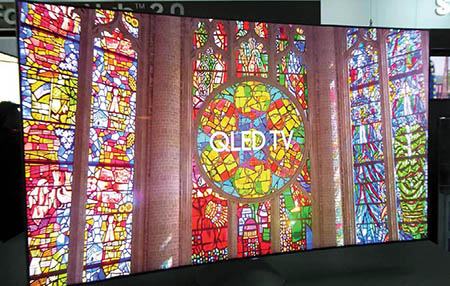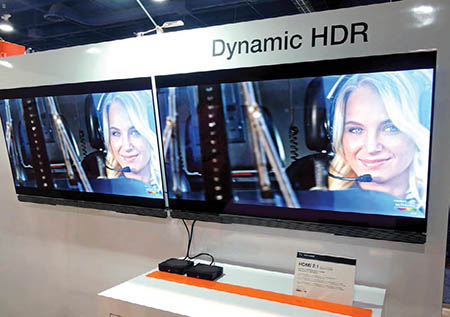CES2017: Incremental Display Improvements
LAS VEGAS—I attend more than a few trade shows every year, but there’s nothing like the Consumer Electronics Show (which has been known as CES and ICES over the years). Each January, more than 150,000 people pack into the Las Vegas Convention Center, Sands Expo Center, and a bunch of hotels and meeting places to see the latest gadgets and technologies.
Some will turn out to be gamechangers. Others will flourish briefly; then fade away. And more than a few will just turn out to be a complete bust with their backers fading into obscurity months later.
A TAME SHOW
In the past decade, there have been a few highly-anticipated shows. At the 2009 event, it was 3D everywhere, every place, on everything. In 2010, tablets were all the rage—that is, until more than 80 of them were put out for inspection. In 2014 and 2015, it was 4K (UHD) TV, and last year, virtual reality (VR) and augmented reality (AR) ruled the roost, along with electric cars and flexible displays.

Samsung claims its new line of Q-LED quantum dot-based UHDTVs can hit a small area peak brightness of 2,000 cd/m2.
Photo by Pete Putman
In contrast, this year’s show was almost tame by comparison. It’s almost as if everyone decided we needed a break from the “boom-to-bust” hype cycles that characterized earlier years, and simply “phoned it in.” That is, there were very few significant breakthroughs at the show, with just about all of those exhibited privately off the floor.
There were a few dominant themes this time around, especially in the world of televisions and displays. Given how quickly Ultra HDTV has come into the market and how quickly retail prices have fallen—as of this writing just before the Super Bowl, it was possible to buy a Tier 1 55-inch Ultra HD set for $499—there wasn’t much chatter about 4K.
But there was quite a bit about high dynamic range and quantum dots (QD). For those who don’t know, QDs are tiny nanoparticles that exhibit a quantum energy effect when bombarded with intense light and emit very pure and stable colors. UHDTVs equipped with quantum dots use an array of blue light-emitting diodes (LED) and a special optical film impregnated with red and green QDs.
Get the TV Tech Newsletter
The professional video industry's #1 source for news, trends and product and tech information. Sign up below.
The results can be spectacular. Samsung, which currently holds almost 40 percent of the worldwide market share for UHDTVs, announced a new line of QD TVs at the show called Q-LEDs, and they claim these sets can hit a small area peak brightness of 2,000 cd/m2. Hisense and TCL—two Chinese brands building a reputation in the U.S. market—also showed QD UHDTVs with high dynamic range and a much wider gamut of colors than we’re used to with the older ITU BT.709 color space.
LG, the number two brand in UHDTVs, countered with an array of large organic light-emitting diode (OLED) UHDTVs that can also reproduce HDR signals, although their small area peak brightness readings are a bit lower at 800 cd/m2. Although LG’s subsidiary LG Display manufactures both LCD and OLED panels (and supposedly will sell them to Samsung), the parent company is betting the farm on OLED TV sales for now. And a new enhancement known as “Nano Cell” was shown by LGD in their suite as a way to produce more intense and pure wavelengths of color light for LCDs.
Sony maintains a number 3-4 ranking in UHDTV shipments and surprised more than a few people by showing 65-inch and 77-inch OLED UHDTVs in Las Vegas. These new Bravia models use the same OLED panels manufactured by LG Display, but with Sony’s video processing “secret sauce” thrown in. And the company continues to show HDR and WCG in large 4K LCD TVs, along with their spectacular modular CLEDIS micro LED display wall that made its debut at InfoComm last year.
Not far away, Panasonic continued to baffle many of us in the trade press by unveiling four new UHD Blu-ray players, sans any accompanying Ultra HDTVs in the U.S. market. (The company continues to sell a 65-inch OLED 4K set in Canada and Europe.) The four new players are considered to be “entry level” UHD models, with the main difference being the absence of WiFi connections on two of them. Who wouldn’t want WiFi on a BD player?

At CES, the HDMI Forum announced v2.1 of the connector, boosting data rates to a mind-boggling 48 Gbps.
Photo by Pete Putman
A handful of companies (mostly Chinese) showed 8K TV demos, but the buzz just wasn’t around them this year. Given that all of the 8K TVs shown to date either use a 98-inch LG Display or 98-inch Innolux LCD panel, there’s not much shock and awe to be had when you see them. LG Display also took the wraps off a 65-inch 8K LCD TV in their suite, while Hisense had a demo of HDR on 4K vs. 8K sets, using static images for comparison and sort of defeating the purpose.
Interfacing all of this stuff becomes problematic when you consider that an Ultra HD signal refreshed 60 times per second with 10-bit RGB color or 12-bit 4:2:0 color requires a data rate in excess of 20 Gbps! So it was somewhat big news when the HDMI Forum announced v2.1 of the connector, boosting data rates to a mindboggling 48 Gbps. (Can you say “fiber-optic cables?”) Not far away, VESA exhibited demos of 4K/120 and HDR using Display- Port version 1.4, alongside Display Stream Compression 1.2. The once-ballyhooed superMHL format, meanwhile, was conspicuous by its absence.
THE REALITY OF VR AND AR
And what of VR and AR? Most of what was shown in this category focused around reducing the size and weight of headgear, which is enough to put many users off the format altogether. Perhaps a significant breakthrough was achieved by semiconductor manufacturer Kopin, who unveiled a slick 2048x2048 color OLED imaging panel that was placed in a firefighter’s oxygen mask to work as an AR infrared detector, locating people during search-and rescue missions. It has great promise for near-to-eye VR displays, too.
Cutting the cord (no, not that kind of cord) has been the dream of numerous chip manufacturers. This year, Canadian fabless semiconductor company Peraso had several impressive demonstrations of 60 GHz wireless USB 3.0 moving a 220 MB movie file through a modified 802.11ad WiFi router, from one laptop to another using a 2 GHz wireless channel, in just seconds. And Keyssa demonstrated a wireless docking DisplayPort cradle that streamed 1080p/60 content from an Amazon tablet to a TV without a hiccup.
I’ve just scratched the surface of this year’s show and will have a more detailed CES recap at the upcoming HPA Technology Retreat in late February. See you there?
Pete Putman, CTS, KT2B, is the president of ROAM Consulting.

